The Tramways of
Lerdo, Gómez Palacio
and Torreón
BY
Allen Morrison
This website is divided into two parts.
Part I covers the years between 1890 and 1940.
Part II considers the period from 1940 to 1952.
Part I: 1890 - 1940
Lerdo, Gómez Palacio and Torreón in north central Mexico - 1,140 km from the capital - are considered together because the three cities were connected by an interstate tramway for 52 years. Lerdo and Gómez Palacio are small, old towns in Durango state. Torreón, across the river in Coahuila state, calls itself Mexico's youngest city; it did not become a ciudad until 1907, but has a half million residents today. Torreón grew at the junction of two railroads, the Mexican Central from Ciudad Juárez to Mexico City, which reached the region in 1883; and the International, from Monterrey to Mazatlán, which arrived in 1888 [see map].
A standard-gauge animal-powered tramway opened from Lerdo to the Mexican Central station in Gómez Palacio in 1890. The Anuario Estadístico [see BIBLIOGRAPHY in Part II] indicates that a narrow-gauge mule line, only 1.856 km long, opened in Torreón in 1900. Its route is unknown, but the photograph below shows trams in the railroad yards. Note the standard gauge track in the foreground, narrow gauge rails beyond [col. Sergio Antonio Corona Páez]:
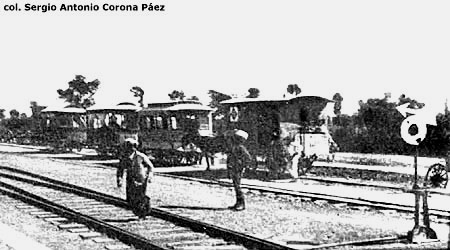
On 4 June 1898 a local poet named Manuel José Othón secured a franchise to electrify the Lerdo line and extend the tramway to Torreón. A song was written to celebrate the event: "De Torreón a Lerdo" remains the city's anthem to this day. Construction began on 16 September 1899 and the Compañía de Tranvías de Lerdo a Torreón ordered 4 closed motor trams, 4 cross-bench trailers and 5 work cars from J. G. Brill in Philadelphia on 26 May 1900. The first 5 km of the line, from Lerdo to the carbarn and railroad station in Gómez Palacio, began operation on 3 March 1901 [see map]. This was the third electric railway in Mexico - preceded only by tramways in Nuevo Laredo in 1890 and Mexico City in 1900. It was the first electric interurban tramway in Latin America. Here is an early view of the carbarn in Gómez Palacio [Album de la Paz y el Trabajo - see BIBLIOGRAPHY]:
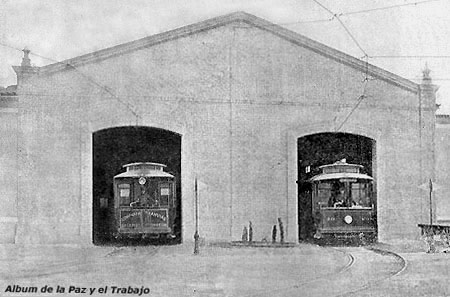
The Compañía de Tranvías de Lerdo a Torreón extended its tracks across the Río Nazas to the railroad station in Torreón on 3 July 1901 [see map]. Just south of Gómez Palacio, still in Durango state, the tramway crossed the Mexican Central Railroad's main line from Ciudad Juárez to Mexico City [Album de la Paz y el Trabajo]:
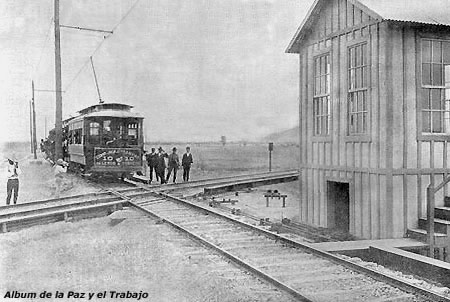
Beyond the railroad the tramway curved across a desolate plain toward the river valley [see map] [Archivo Histórico "Juan Agustín de Espinoza, S.J." at the Universidad Iberoamericana in Torreón]:
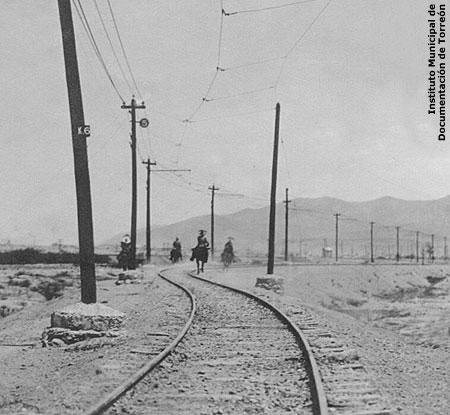
The bridge over the Nazas River was 200 m / 650 ft long. The view is north, toward Gómez Palacio [see map]. The motor car and trailers are about to arrive in Coahuila state [Album de la Paz y el Trabajo]:
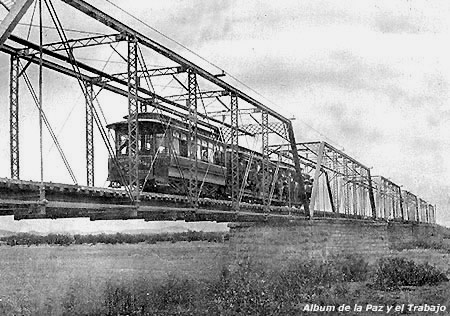
CTLT ordered 6 more passenger trams from Brill in 1901 and 4 freight trams from St. Louis Car Co. in 1903. By 1904 it had a fleet of 23 vehicles. The photograph below was probably taken at the railroad station in Torreón [see map] [Modern Mexico, New York, November 1906, p. 33]:
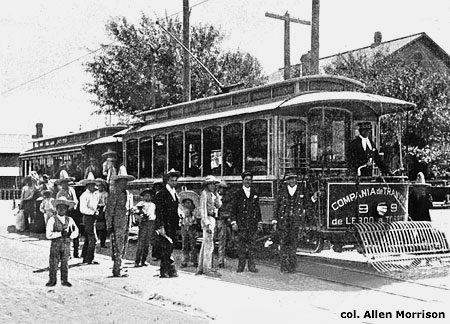
The company did a substantial cargo business in the rural areas of Durango state. The location of this 5-car freight train is unknown [Album de la Paz y el Trabajo]:

Here is another passenger train - again composed of closed motor car and two open trailers - leaving the bridge over the Nazas River [Archivo Histórico "Juan Agustín de Espinoza, S.J." at the Universidad Iberoamericana in Torreón]:
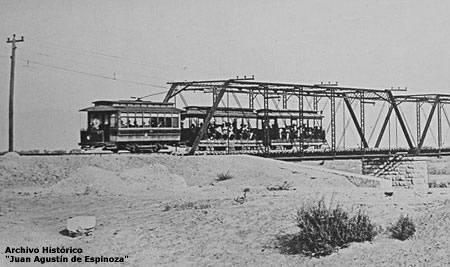
And that was only Torreón's first line. A second organization, the Compañía de Electricidad y Tranvías de Torreón, purchased 5 passenger trams and 4 work trams from American Car Co. in St. Louis and opened a local streetcar system in Torreón in December 1904. The urban system consisted of four numbered routes - three circular services along Avenidas Hidalgo and Matamoros and a branch to La Metalúrgica factory on the city's south side [see map]. The builder's photo below shows CETT's first car, a "Metropolitan" type [Street Railway Journal, New York, 10 September 1904, p. 389]:
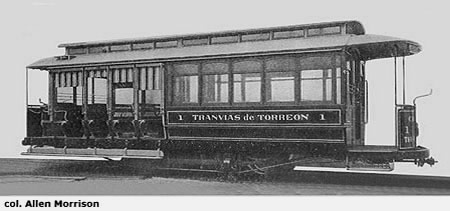
CTLT merged with CETT in 1905, renamed itself Ferrocarril Eléctrico de Lerdo a Torreón and ordered 14 more passenger cars from Brill, including 4 double-truck "Narragansett" type open cars. With the 9 vehicles that it acquired from CETT it had a fleet of 33 passenger trams in 1907. Gauge of both the local tramway and the interstate interurban line was 1435 mm. Here is part of the new company's letterhead [document donated by the Brittingham family to the Archivo Histórico "Juan Agustín de Espinoza, S.J." at the Universidad Iberoamericana in Torreón]:
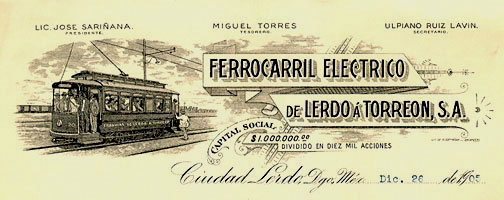
FELT adopted the route numbers established by CETT for the local lines. The car below was photographed in 1909 on route 3, a counterclockwise loop on Avenidas Hidalgo, Victoria, Escobedo and Matamoros [see map] [illustration donated by Marco Antonio Contreras Illescas to the Archivo Histórico "Juan Agustín de Espinoza, S.J." at the Universidad Iberoamericana in Torreón]:
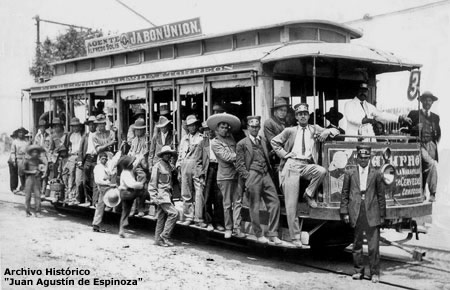
Here is another scene on the local system. FELT "No. 10" is on Av. Matamoros in a residentail zone [see map] [Archivo Histórico "Juan Agustín de Espinoza, S.J." at the Universidad Iberoamericana in Torreón]:
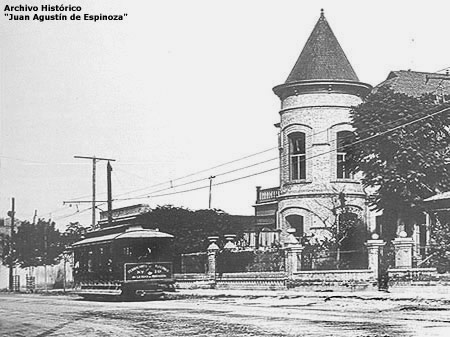
And, amazingly, tramway development did not stop there! The most unusual tramway in Torreón - perhaps in all Mexico, perhaps in the whole world - was built by the Compañía Bancaria y de Tranvías Wah Yick, founded in 1906 by a Cantonese named Wong Foon Chuck. Chinese immigrants flocked to Mexico's boom town, opened laundries, restaurants, clothing stores and banks and developed agriculture and real estate on the city's east side. In June 1907 CBTWY announced that it would build an electric railway from Torreón to Matamoros and San Pedro 26 km east of the city. Nothing came of that plan, but in June 1908 CBTWY began laying track for a local tram line, from the cemetery on the city's west side along Av. Morelos to the Chinese settlement on the east [see map]. FELT tried to prevent CBTWY from crossing its tracks, but a thousand Chinese completed the job during the night of 1-2 January 1909. Unfortunately, news sources dried up after that date. It is not known if CBTWY ever opened its line - or what vehicles it used if it did. Anti-Chinese sentiment festered during the Mexican Revolution and in early 1911 the Madero forces followed the tramway line into the city [Archivo Histórico "Juan Agustín de Espinoza, S.J." at the Universidad Iberoamericana in Torreón]:
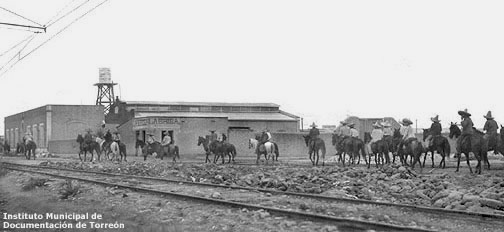
Between 13 and 15 May 1911, the Revolutionists killed 303 Chinese in Torreón, including most of the officers and employees of the CBTWY.
Records of the CBTWY preserved at the Universidad Iberoamericana in Torreón speak mostly of finances and say little about the tramway. Not much is known about the development of the FELT system - the interurban and four local lines - during the next half century. Here is another photograph of the trestle, this one taken on 10 September 1923 of a motor car and three trailers. The view is south, toward Torreón [Archivo Histórico "Juan Agustín de Espinoza, S.J.", Universidad Iberoamericana, Torreón]:
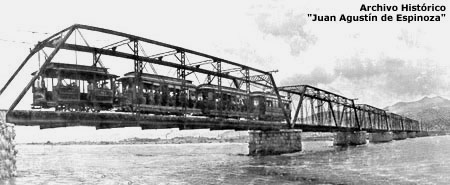
McGraw Electric Railway Directory (New York) reported 22 passenger motor cars, 20 passenger trailers, 5 work cars and 22.3 km of track in Torreón in 1924. A U.S. government survey published in 1925 [see BIBLIOGRAPHY] noted 18 passenger motor cars, 22 passenger trailers and 15 work cars, but did not mention track length. The postcard view below, from the 1930s, shows the geography of the region. The photographer was flying southwest over the Río Nazas - Coahuila state on the left, Durango on the right [see map]. The bridge in the foreground was for automobiles. The 6-span bridge below the dam was the tram line. The farthest bridge, near the hills, was the steam railroad. The city of Torreón is unfortunately just out of sight [col. AM]:
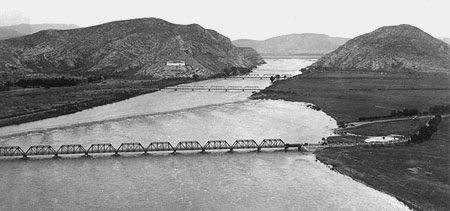
The BIBLIOGRAPHY
is at the end of Part II
go to
Part II: 1940-1952
go to
INTRODUCTION & INDEX MAP
Copyright © 2003 Allen Morrison - ALL RIGHTS RESERVED
|





























